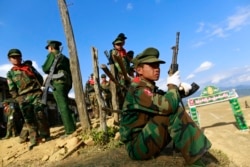Increasing conflict between Myanmar’s ethnic armed groups and government forces during the last year has increased civilian casualties amid mounting allegations of war crimes.
With the U.N.’s International Court of Justice order that the country "take all measures within its power" to prevent any acts of genocide against ethnic Rohingya Muslims, who fled the country amid a bloody military crackdown in 2017, other ethnic minorities that have been fighting for decades over control of resource-rich territory are coming forward to voice their concerns over past documented atrocities, also carried out by the Myanmar military.
The mountainside village of Pain Lone in Shan State was the site of such conflict last fall between government forces and the Ta’ang National Liberation Army, an armed ethnic group based in the region, panicking students scrambling for cover as their afternoon classes were ending.
"The sound of the helicopters was very terrifying and the loud explosions falling around the village were terrible,” recalls local instructor U Maung Chone, who teaches in the remote mountain settlement.“
It doesn’t matter if they are falling in the town or just in the area. The explosions were very frightening for the kids,” the 45-year-old said, adding that he’d never seen army helicopters in more than two decades of teaching.
Clashes and IDPs
Clashes between Myanmar forces and the TNLA also spilled over into neighboring villages, displacing about 2,000 people at that time.
At least four Myanmar combat helicopters flew into the area during the September 13-16 skirmishes that saw at least 15 civilians killed and 30 injuries, according to Shan press reports.
The recent round of fighting in the region began shortly after the latest of many “temporary ceasefires” between three local ethnic armed groups, the TNLA among them, and the Myanmar Army neared its end last August. The three armed forces mounted counteroffensives at five locations, including a prominent military academy on August 15.
Ten groups have signed a National Ceasefire Agreement since the peace process was launched by President Thein Sein in 2011.
Major armed groups including the Kachin National Liberation Army, the Arakan Army and the TNLA have yet to sign a permanent agreement, with land rights and the withdrawal of government troops from ethnic regions being among key issues yet to be resolved.
About 8,000 civilians were displaced by fighting in Shan State in 2019 with thousands more being uprooted by skirmishes in Kachin, Karen and Rakhine states, fueled by battles for profitable natural resources and large-scale development projects.
Key trading partners including China and Japan have defended the position of the Myanmar government against recent allegations of genocide against the Rohingya Muslim population as massive multimillion dollar projects such as special economic zones move forward.
Observers worry that international businesses will continue to ignore many of the atrocities allegedly being carried out by Myanmar army, thereby emboldening them to continue such acts.
There is no international pressure, so the army faces no accountability or condemnation, according to Shan human rights activist Charm Tong.
The previously ruling junta’s forces “scorched earth” campaign against ethnic minorities displaced over 300,000 ethnic Shan civilians from 1996 until 2001, with a campaign of terror and abuse to destabilize community support for opposing ethnic armed forces. I questioned this and you added government but maybe this phrase is right after all — it was an SPDC campaign of terror and abuse to destablize public support for the opposition ethnic forces, right? so we should leave this the way it is, right?
Tong is now concerned that a new generation could be facing similar abuses and persecution.
"The young people and the children who have witnessed or experienced the violation themselves suffer and some may take years or decades to go through it and sometimes they would only speak if they trust or they can express the way that for example during writing about the story writing the story about themselves as part of the healing,” she said.
Impact of attacks on children
Growing up with the constant threat of sudden attacks has increased the stress on many of the displaced children in the ethnic regions.
In neighboring Kachin State, about 100,000 civilians remain displaced by a conflict renewed in 2011 when a cease-fire agreement was broken between the army and the Kachin National Liberation Army.
In Kachin state’s biggest internally displaced persons camp of Je Yang, families have faced nearly a decade of renewed fighting, and for parents like Mary Renu, protecting their children from the bombardment of bad news is an overwhelming task.
Renu said her 10-year-old son, Naw Din has become less talkative in recent months as he conveys his fears through his artwork, drawings of soldiers shooting machine guns, helicopter gunships and other acts of war, viewed daily from online video reports that are rehashed in camp classrooms.
In light of the U.N. court’s ruling, other ethnic groups are hoping to have their day in court, and as conflicts continue in Myanmar’s resource-rich regions, rights groups and refugees hope increased scrutiny of the military will bring with it accountability and security for civilians.














